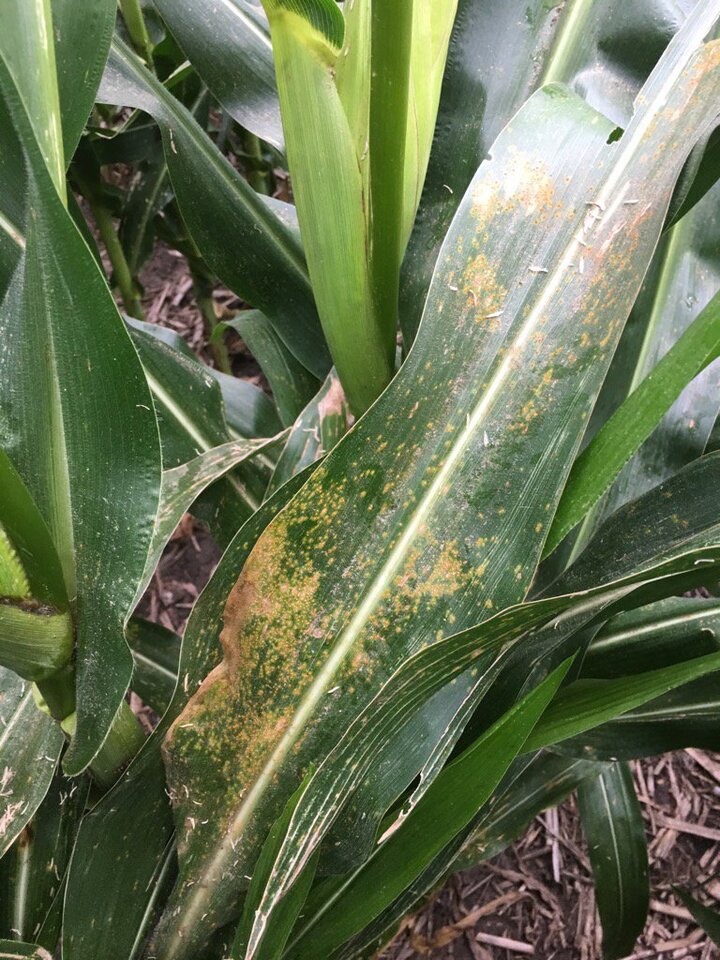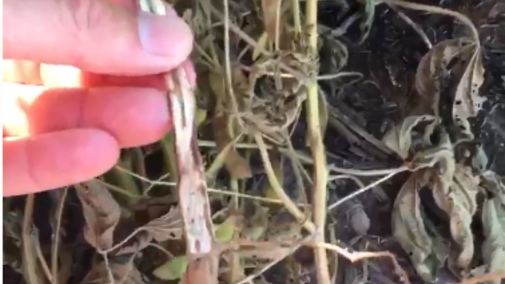Loren Giesler, Extension Plant Pathologist: Charcoal rot is starting to show up in some Nebraska soybean fields (view video). Affected plants will wilt and when the epidermal layer of the stem or roots is pulled back, a grey or silvery discoloration with microsclerotia will be visible. At this point in the season the only management aid is irrigation management. More on charcoal rote in this July CropWatch article. For more video reports follow Giesler on Twitter @MulletManLG or follow @UNL_CropWatch. For more information on soybean aphid growth, development, and management see two stories in the July 20, 2017 CropWatch. (8/11/17)

On Wednesday Jeff Theis (@TheisAg) tweeted unfortunate news to @UNL_CropWatch: "Southern rust starting to show up in earlier treated corn fields in Fillmore County" and @BohlingMatt asked "Will it beat it?"
Extension Plant Pathologist Tamra Jackson-Ziems (@tjcksn) tweeted back: "Although we can't know for sure, forecasted temperatures that are below normal with highs in the lower to mid-70s should help slow it down, but the fungus will survive and take advantage of warmer temperatures later if they develop. Not out of the woods yet, but looking better." (8/9/17)
Tom Hunt, Extension Entomologist at the Eastern Nebraska Research and Extension District: Since the weather has been cooler, and soybean aphids do better in cooler weather, I went out to check a few fields in northeast Nebraska. Populations were still low, but a bit higher than my last report July 17. Growers need to monitor their soybeans for this pest through August, although chances of populations growing to economically damaging levels diminish as we near the end of August. To date, I have had no reports of damaging soybean populations in Nebraska. (8/8/17)
Charcoal rot ID and Management #soybeans @CropNetwork @Crop_Protection @UNL_CropWatch @marketjournal @AlbertTenuta @badgerbean pic.twitter.com/D5FvWf56SZ
— Loren Giesler (@MulletManLG) August 11, 2017
In this short video Loren Giesler takes viewers to the field to examine symptoms of charcoal rot.
Charles Shapiro, Nebraska Soil Scientist, Eastern Nebraska District: We receive a little rain over the last couple of weeks, which helped soil moisture conditions, although some field areas may be showing nutrient inefficiencies exasperated by drought conditions. (8/8/17)
Keith Jarvi, Extension Educator in Dixon, Wayne, Cedar and Knox Counties: Wayne received an inch of rain in June, one in July, and one last week in August, which is close to average; however, conditions are dry and a lot of irrigation is ongoing. Late-planted corn is feeling the effects of limited soil moisture, while early planted corn, planted into a full water profile, looks better. Growers have taken a third cutting of alfalfa. (8/8/17)
John Wilson, Extension Educator in Burt County: Conditions are dry here, but the cooler weather has provided a little relief. This week a crop scout reported both southern rust and bacterial leaf streak, but not at high levels. Growers have taken their third cutting of alfalfa. (8/8/17)
Steve Melvin, Extension Educator for Irrigated Cropping Systems: We’ve gotten some spotty rains and may not be as dry as some areas as crops here are looking good. We’re seeing painted lady butterflies in soybean. (8/8/17)
Ron Seymour, Extension Educator in Adams County: We’re seeing painted lady butterflies in soybeans, bean leaf beetles, and other defoliators, bacterial pustules, and brown spot. In corn we’re seeing southern rust, bacterial leaf streak, gray leaf spot , and western bean cutworm (which hasn’t been a huge problem as a lot sprayed when they needed to), and spider mites. We’ve had some rain and many are irrigating to keep ahead. Corn is in late milk stage and soybeans are starting to fill. (8/8/17)
Sarah Schlund, Extension Educator Reporting for Dawson, Buffalo, Hall Counties: Pollination of both corn and soybeans looks good with most of the corn pollinating fairly well. We did have a couple reports of some ears that did not get pollinated clear to the tip, but hopefully yield will be good at harvest time. Third cutting of alfalfa is down in spots and some folks are thinking about a fourth cutting yet this season. I have seen quite a bit of Palmer amaranth in field borders, especially in soybeans this year. I have been encouraging mechanical removal at this point. Grasshoppers are bad again this year, especially in pastures and field borders. Several farmers have already sprayed for grasshoppers and I have heard reports of folks with pasture ground also spraying. Dawson County is a hotspot for grasshoppers this year with economic thresholds being reached in certain parts of the county, especially on pasture ground. (8/7/2017)

